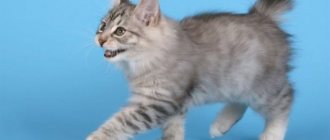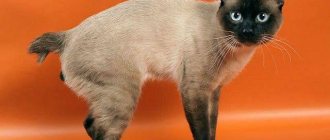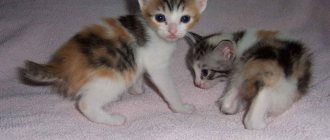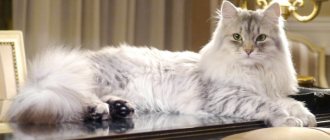The Kurilian Bobtail is an interesting representative of the cat family. Due to its size and habits, it has taken root well in rural areas. It’s difficult to call her sweet and gentle; many of her character traits suggest that she is a dog in cat’s clothing. You shouldn’t make a fuss towards the bobtail; you’ll be ignored – call him by name.
Such habits are sure to endear dog lovers who do not like the amount of attention that a dog usually needs. Of course, a cat can be raised to be affectionate and gentle, but it is difficult to perceive the Kuril Bobtail as a sissy.
The Soviet Union is considered the birthplace of the breed - it was thanks to Soviet felinologists that the cat came to the mainland and received recognition. At the same time, there is reason to believe that the breed is more than 200 years old, and it originated, then, on the Japanese islands.
Description of the Kurilian Bobtail breed
Popularity 77th place among 87 cat breeds
Lifespan:
12-15 years
Height:
up to 30 cm
Country of origin:
Russia
Average price:
10-20 thousand rubles
Weight:
up to 7.5 kg
Latest articles Cat health
Ataxia in cats: what it is, how it manifests itself and is treated 01/23/2022 151 0 0
Cat health
Leukemia, or viral leukemia in cats 01/23/2022 140 0 0
Weight table by month
The weight of an adult Kuril Bobtail reaches 4-7 kg, in cats - 5-9 kg.
| Age | Cat | Cat |
| 1 month | 280-400 gr | 330-460 gr |
| 2 | 550-750 gr | 880-1.2 kg |
| 3 | 1-1.2 kg | 1.1-2.2 kg |
| 4 | 1.3-2.4 kg | 1.8-3.2 |
| 5 | 1.7-2.7 kg | 2.6-3.6 |
| 6 | 2.6-3.4 kg | 3-4.4 kg |
| 8 | 3-4.1 kg | 4-5.2 kg |
| 10 | 3.2-4.4 kg | 4.4-5.8 kg |
| 1 year | 3.5-5 kg | 5-6.8 kg |
| 2 | 3.8-6 kg | 5.4-6.6 kg |
Key facts
The main characteristic of the Kurilian Bobtail is its tail. Outwardly, it resembles a fur ball. This trait was inherited by the breed from its Japanese neighbors.
Despite the fact that cats are proud creatures by nature, they are seriously attached to the family in which they live, but they can only have one owner. Do not pay attention to the similarity of these cats with wild predators. They are friendly and playful by nature.
Bobtails will only be welcome for children in the house. Don't want your child to be bored alone? The Kurilian Bobtail cat will take part in any game. Bobtails also treat other pets leniently, however, given their cat-like nature, you should still not let ornamental birds or rodents get close to them.
Be prepared for the fact that from time to time the bobtail will test your nerves and show excessive nobility and willfulness. Do not succumb to the furry's provocations, otherwise he will lose respect for you. The description of the Kuril Bobtail breed explains its dominance by the conditions in which the breed was bred.
The health and life expectancy of the Kuril Bobtail are encouraging: seals live up to 15 years, and there are also those individuals that have reached the 17-18 year mark.
Vaccinations and antiparasitic treatments
Despite a cat's typically reclusive lifestyle, vaccinations are necessary to keep her healthy. The first vaccination is given at 2-3 months of age. Then repeat every year at the same time.
10 days before the procedure, anthelmintic and antiparasitic (fleas, ticks) treatment must be carried out. The veterinarian selects anti-helminth medications and vaccines.
It is not recommended to vaccinate pregnant cats and kittens during the teething period. After vaccination, the pet requires a more attentive attitude towards itself, because it may become unwell. At this time, contact with other animals should not be allowed.
Following the vaccination schedule will help maintain health and prolong the life of your pet. The lifespan of a Kuril cat is from 12 to 18 years.
History of the origin of the Kuril Bobtail
The southern part of the Kuril Islands is a well-known place. For many years, Japan and Russia defended their rights in this territory. However, the Russian Federation still remained their rightful owner. The country received not only a piece of land in the Far East, but also the right to be considered the homeland of one of the most unusual cat breeds.
Most felinologists believe that bobtails descended from those short-tailed cats that inhabited the islands since the 18th century. Their distant relatives were wild cats, which appeared thanks to the union of Siberian cats and Japanese bobtails. Their story also deserves special attention.
In Japan, bobtails are considered a symbol of good luck, as evidenced by ancient beliefs. People treat representatives of this breed with respect, give them to each other on major holidays, and sometimes even overprotect them. The origin of these animals is no less sacred. Their ancestors are considered to be white cats that lived in temples and guarded the followers of Buddha.
The Japanese often brought their animals to the Kuril Islands as part of military or other expeditions. They were even used as guards on farms where fur-bearing animals were bred. However, cats are not animals that will obey in everything. They are too proud for this. It is for this reason that many Japanese bobtails simply ran away from their owners into the wild nature of the Kuril Islands.
Generations passed, and bobtails acquired new features that helped them adapt to the harsh nature. Now these cats were no longer afraid of water, their claws were no longer hidden in soft paws, and the animals themselves became much larger, which allowed them to hunt larger game.
Siberian cats came to these lands along with settlers. They made friends surprisingly easily with their Japanese brothers, who by that time had completely gone wild. Time passed, the breeds mixed until the familiar Kuril Bobtails saw the light of day.
However, local residents did not immediately notice that a new breed had formed literally before their eyes. Therefore, the selection of Kuril Bobtail cats began a little later. Felinologists paid attention to the Kurilians only towards the end of the 20th century. Until this time, bobtails were mistaken for Japanese cats. No one knew then that those same furry creatures were not just feral cats from the Land of the Rising Sun, but truly something new in the already diverse fauna of the earth. But in 1991 everything changed dramatically.
At this time, the first breed standard was formed from cats brought from the Kuril Islands by the Soviet felinological organization. Tatyana Bocharova played an important role in this. She conducted research and found that the short tail of the bobtail is inherited by absolutely all descendants, which means that this is not a genetic anomaly, but a full-fledged feature of the breed.
So Kuril cats were officially registered as a separate breed in the Siberian Federal District. However, this was not enough. Now there was another question - how to achieve recognition from European organizations?
In 1994, a seminar was held at which Russian breeders asked how to refine the breed standards and achieve recognition from the international organization WCF. A year later, the breed received its recognition, and with it an explosive flurry of interest among Europeans. Bobtails have become frequent guests of exhibitions in the Czech Republic, Poland, Italy and many other countries. Nurseries opened everywhere, breeding both short-haired representatives of the breed and long-haired ones. However, the long-haired representatives quickly divided into cats with long and semi-long hair.
In 2001, the standard of the Kuril Bobtail was once again clarified, but overall remained unchanged. In 2012, the FIFe organization officially approved the independent Kuril Bobtail breed. In the same year, the breed appeared on the TICA lists.
To this day, bobtails appear in more and more places, winning the hearts of more and more people. These cats are highly valued in Europe for their kindness and devotion, and in the east, bobtails have become integral companions of hunters and fishermen, who were able to fully appreciate the hunting qualities of fluffy cats.
Colors
Colors are varied, but certain colors are prohibited in most show systems: fawn, lilac, chocolate, cinnamon, acromelanic (Tonky, Siamese and Burmese) and ticked colors.
The amber color was discovered only recently and has not yet been included in the general standard.
Acceptable colors:
- Tortoiseshell and solid (black, red, cream, blue, white);
- Tabby;
- Marble (red, black, blue, cream, tortoiseshell);
- Brindle (black, red, tortoiseshell, cream, blue);
- Spotted (red, black, blue, cream, tortoiseshell);
- Harlequin (including marble);
- Bicolor;
- Wang;
- With white spots.
In the photo there are cats of the Kuril Bobtail breed of popular colors: black, white, tortoiseshell
What does a Kurilian Bobtail look like?
The appearance of the bobtail is contrasting. Although he is not tall enough, his muscles are the envy of any other cat. Thanks to its strong muscles, the animal can run very fast and make incredible jumps. It is very easy to distinguish a female bobtail from a male, because the breed has highly developed sexual dimorphism: males are several centimeters taller than females and 2-3 kilograms heavier. In the photo of the Kurilian Bobtail you can immediately see what gender the animal is.
Muzzle
The bobtail's head is triangular, with rounded corners. The whisker pads are well defined and quite dense. The skull is flat.
The muzzle is wide and round in shape. The stop is poorly marked and almost invisible. The forehead is flat, smoothly transitioning into a wide, short nose. Its lobe is quite large and well defined. The chin is strong, with smooth outlines that are clearly visible in profile. The cheekbones are low, but not as much as in Siberian cats.
The ears are triangular, not too large. Planted far apart, high. The distance between the ears should be equal to the width of the ear itself. It may be a little more, but less is unacceptable. At the tips of the ears there are small tassels-decorations. This gives them a lynx-like appearance.
The eyes are slightly slanted, inherited from their eastern ancestors. This gives them a unique aesthetic and mysterious look. The eyes are set quite wide, on the same line. The color of the iris can be green or yellow. In the case of two-color representatives, blue eyes are acceptable. Eye color is not strictly regulated by the standard.
During the time that Japanese bobtails lived in harsh Siberia, they acquired powerful jaws. Their bite is pincer-shaped, with a full set of teeth.
Body type
What does a Kurilian Bobtail look like? His neck is covered with thin skin, under which powerful muscles are hidden. Due to the compacted coat in this area, it appears that the bobtail has a wide neck.
The body is dense, strong, however, which is typical for all types of cats, very flexible and pliable. The body is elongated, the back is arched, the croup is slightly raised.
The main distinguishing feature of the bobtail is its tail. It rises above the back. Its length varies from 3 to 13 cm depending on the length of the animal’s fur. However, even such a short tail has 4 varieties:
- The “stump” is assembled from vertebrae tightly adjacent to each other. It can either be held straight or be bent down with a hook;
- “broom” – 5-10 vertebrae, straight. 1/3 smaller than a regular tail;
- “spiral” is one of the most common among bobtails;
- The “retracted bobtail” includes 5-7 vertebrae that curl into a loop towards the tip of the tail. Considered a defect.
The shape of the pompom itself is not limited in any way in the standard, so it can and even needs to be trimmed periodically. The varieties of the Kuril Bobtail are not distinguished on this basis.
The hind legs of bobtails are much longer than the front legs. Their developed muscles allow cats to jump long distances. Bobtail paws are round, with tightly clenched toes. The claws do not retract into the pads, which is why the cat makes a scratching sound when walking, characteristic of dogs.
Coat and color
Kurilian Bobtails are divided into two types based on the length of their coat:
- Short-haired representatives have fine wool. On the tail it may be longer than on the rest of the body.
- Long-haired cats, accordingly, have longer or medium-length hair. But even they may have longer hair in the lower part of the body and on the tail. In addition, they have a puffy “collar” and “pants”.
The color of the Kurilian Bobtail can be almost any color. There are several common varieties: smoke, tricolor and tabby. The breed standards do not include chocolate, lilac, Abyssinian and Burmesse colors.
Common signs of bobtail cats
There are several types of bobtail cats on earth today. They are all united according to several main characteristics:
- A short small tail measuring approximately 2 to 12 centimeters;
- Sufficiently long (longer than the front) and strong hind legs;
- Quite a low timbre of voice;
- No need to mark territory (unless two competing cats live in the same apartment);
- Muscular physique.
It is also worth noting the special character that distinguishes all cats of the breed: they are all fearless, well adapted to life in the wild, and able to stand up for themselves. But at the same time they have a devoted, almost dog-like heart. They become attached to the owner, and not to the place, they love him with all their cat soul. They lend themselves very well to classical training, the “fetch” command is easy to execute, and these amazing cats feel quite comfortable on walks, even if the owner walks his pet on a leash.
Character of the Kurilian Bobtail
Although Kurilian Bobtails may look wild, they are actually famous for their kindness and friendliness. Even with a change of owners, the bobtail quickly gets used to the new owners. He will not sit with a sad face under the bed until you pull him out of there, but on the contrary, he will come up to you to get acquainted.
These cats are active and love when all family members participate in games. Sometimes they look more like dogs: after all, they also like to fetch toys that the owner throws for them.
This cat will love his family as devotedly as a dog would. Nothing is more important to him than his family. The animal will protect the family by taking a threatening pose and meowing menacingly. Well, the owner of the bobtail has a special place. If you are lucky and a furry guard has chosen you as his owner, be proud of it. Now he will accompany you everywhere and become an integral part of your life.
The bobtail has no complaints about other pets. He will happily share his home with either another cat or a dog. However, this does not apply to birds and rodents, which the cat will perceive exclusively as prey. A suddenly heightened natural instinct can lead to unpleasant consequences.
Although this baby looks kind and harmless, be prepared for his outbursts of pride and independence. The bobtail will definitely not want to sit in your arms for a long time, because this is not a plush toy, but a real hunter. If the owner does not pay enough attention to the animal, then soon the cat will simply begin to live by its own rules, feeling like the master of the house.
If this happens, it will not be easy to overthrow the furry tyrant from his throne. You will encounter cat protest and harmfulness. He is unlikely to limit himself to torn curtains, damaged things and broken dishes. The character of the Kurilian Bobtail will deteriorate if the owner devotes insufficient time to raising it.
Has the cat become completely lazy and almost doesn’t want to play with you anymore? Take it with you on a hike or to the countryside! There you will see your pet in a completely different light. In the fresh air, the animal will quickly remember all its hunting roots. Now there will be no time to lie on the couch all day long, because you have to catch butterflies, fight with the neighbor’s cats, and explore the territory.
Advantages and disadvantages
- They are not afraid of water.
- Good hunters.
- They don't mark their territory.
- They know how to warn about dangers.
- They learn quickly.
- Friendly.
- Devotees.
- They have good health.
- They love to talk.
- They can be intrusive.
- Loneliness is difficult to bear.
- They do not like to sit on their laps or hands.
- Bobtails often have problems with the toilet and anus.
- Demanding something, they howl unpleasantly and frighteningly.
Raising a Kurilian Bobtail
Nature has not deprived bobtails of intelligence. A cat can not only guess your mood, but also understand what you are talking about. Raising such a cat is not difficult, but it is important to clearly define the boundaries. Do not hit the cat under any circumstances; it is better to explain to him that he is behaving inappropriately, in some other way. Teach him the word “no”. This will help you a lot in the future.
If your pet does violate any of the rules, have an educational conversation with him. It is important to do this as quickly as possible after committing a “crime”, otherwise the cat simply will not understand you.
As soon as the pet has matured, it begins to test the strength of its owner’s nerves and tries to take the place of the boss in the house. At this time, it is important to let him understand that you do not intend to give up your place to him, moreover, for disobedience he will be punished in the same way as always.
For people with a strong character, raising a bobtail will not cause any problems. The cat will quickly get used to the tray and scratching post and will not cause any problems.
Bobtails are also quite easy to train. Curiosity and activity help them in this. They are able not only to learn together with their owner, but also to learn from the experience of their own kind. The main thing is to make a game out of training, and then the cat will surprise you with its success.
Looking for a Kurilian Bobtail? Find your pet from 2 offers Buy
Education and training
Kurilian bobtails have developed intelligence, which allows animals to understand the meaning of over a thousand words! Raising a pet is not difficult: the main thing is to correctly determine the boundaries of what is acceptable. You should not raise your hand to the cat, because there are other ways to tell your pet about your dissatisfaction. A stern tone is quite enough. This tactic also works if you want to stop your bobtail from acting inappropriately. The word “no” will certainly prevent unwanted consequences.
If your pet has escaped your close attention and misbehaved, have an educational conversation as soon as possible. Otherwise, the bobtail will not understand what exactly he has done wrong.
Upon reaching a certain age, “smokers” begin to test the owner’s strength, making attempts to take a leading position in the house. At this stage of education, you will need to be able to adequately respond to the animal’s behavior and make it clear that you do not plan to cede dominance to your wayward furry friend.
Otherwise, raising Kurilian Bobtails is not difficult, especially for people with a strong character. Teaching your pets to use the tray and scratching post for their intended purpose is also not difficult.
Representatives of this breed are easy to train. Their inquisitive mind allows them to learn new tricks and adopt the skills of their tailed brothers. Turn the training process into an exciting game - and soon your bobtail will delight you with brilliant execution of commands!
Health of the Kurilian Bobtail
Possible diseases
Due to the fact that the ancestors of bobtails lived in snowy Siberia, these cats have excellent immunity. The health of the Kurilian Bobtail is enviable. However, there are several diseases that are common among this breed:
- haemorrhoids;
- rectal prolapse;
- cracks and inflammation of the anal mucosa;
- urolithiasis disease.
These cats are also not immune from infectious or parasitic diseases, so it is very important to get vaccinated on time and visit a veterinarian.
Reproductive health
A bobtail can be sterilized only after reaching 12 months. Some representatives have a hard time with anesthesia and can recover from it within several days. If you decide not to sterilize your cat, but to breed offspring, then keep in mind that a bobtail litter usually has from 3 to 8 kittens.
Diseases
The immunity of cats of this breed is enviable. But they also have weaknesses.
The first thing you should pay attention to is the ponytail, or more precisely, the area under it. At the very first inspection, find out whether there are any cracks, irritation or ulcers. Such a short length is a prerequisite for the occurrence of an inflammatory process or prolapse of the anus. The Kurilian Bobtail should be examined regularly, and if damage is found, take it to a veterinarian for examination. Remember: if you feed your cat poorly, he will develop this kind of illness quickly.
Ordinary sea buckthorn oil helps to deal with small cracks: they lubricate the anus area with it and make sure that the cat does not lick it right away.
The second nuance: in Kuril Bobtails, the urine pH is significantly different from the urine of cats of other breeds (7-7.5 versus the usual 6-6.5). Therefore, they rarely suffer from urolithiasis of the alkaline type.
Timely and regular vaccination will help protect your pet from a number of diseases - rabies, rhinotracheitis, panleukopenia, calicivirus, leukemia, peritonitis. The kitten receives its first vaccinations at the nursery, but in the future you will have to learn the vaccination calendar and take your pet to the doctor yourself.
Information about the procedures is entered into the veterinary passport. You should not vaccinate yourself (if you do not have the appropriate education: a mistake can lead to serious consequences. Do not try to vaccinate your pet against all diseases at once: this is too much stress on the immune system!
Features of feeding and diet
Bobtails are completely unpretentious in food. But you shouldn’t feed him table scraps either. For a cat who regularly participates in exhibitions, the best food will be premium food. If your pet does not win medals and titles, regular food with the addition of boiled meat and vegetables will do.
There are several things that you should not feed to a representative of this breed:
- eggplants, potatoes, any legumes;
- fish;
- sweets;
- raw or fried meat;
- dairy products;
- fatty meat (pork, lamb).
You can give your pet water. If you use tap water, it needs to sit for at least 24 hours.
Catering
High-quality food for the Kuril Bobtail is the key to a long and healthy life. So remember:
- An adult animal is fed 2 times a day: in the mornings and evenings. You should wash the bowls once a day (do not use any detergents other than laundry soap) and pour clean water at a comfortable temperature into the drinking bowl every day. Kittens 2-5 months old are fed 3-6 times.
- Don't feed your cat from your table. Fatty soups, fried potatoes, chocolate and other favorite foods, unfortunately, are real poison for the animal. Sweet, salty, smoked, sour, canned, flour and baked goods are strictly prohibited.
Natural products
Important diet foods:
- Meat (beef, chicken, turkey, rabbit).
- Fish (both river and sea).
- Plant foods (zucchini, pumpkin, carrots, green salad, asparagus, broccoli, parsley, dill, beans).
- Chicken yolk (boiled), quail eggs.
- Porridge (rice, oatmeal, buckwheat, millet).
- By-products (liver, kidneys, ventricles, hearts).
- Dairy products cause metabolic disruption. The same applies to potatoes, baked goods, dog food, and human canned food. But sprouted oat grains for bobtails are one of their favorite treats.
The water should either be passed through a kitchen filter or left for a day in an open container.
Recommended food
When choosing dry food, buy only food from the holistic group. Applaws, Farmina N&D, Jaguar. Other foods are not suitable for Kurilian Bobtails.
Below are the recommended holistic class foods. Links with the names of the food are clickable, on them you can, within our website, get acquainted with the descriptions of the food and read reviews from owners of Kuril Bobtail cats.
| Holistic | Holistic | Super premium |
| Acana | Go Natural | Organix |
Care and maintenance
Thanks to the undercoat, cats' fur rarely gets tangled, which means it does not need daily brushing. It is enough to comb out dead cat hair once or twice a week to prevent it from spreading throughout the house. This can be done either using a comb with metal teeth or using a special glove. Do not scratch your cat against the grain: this will damage its structure and create unpleasant sensations for your pet.
Bobtails love to swim, but you should not do this procedure too often. The animal's skin may dry out and the hair coat may become too thin. Neither a special conditioner nor a mild shampoo will help. Only take baths when your pet needs it. Don't forget that cats are not dogs; they never miss an opportunity to get a good lick. Don't neglect a towel after showering. Even the slightest draft for a wet baby can cause illness. It is recommended to dry the cat with a hairdryer.
Bobtails cannot fully retract their claws. However, you don't have to worry about your pet accidentally scratching you. The claws wear down while walking and also when the cat uses a scratching post. Of course, it wouldn’t hurt to purchase special nail clippers. Trim your cat's claws very carefully, otherwise you risk damaging the blood vessels in them.
Check your cat's eyes regularly for dirt. They need to be washed two to four times a week, using a special solution sold in pet stores. Don’t forget about your pet’s ears, wiping them with a cotton pad with a special lotion. If this is not done, wax will accumulate in the cat's ears, which can cause infectious diseases.
You need to brush your cat's teeth at least once a week. Never use human toothpaste. To avoid torturing yourself and your pet by using a regular toothbrush, get a special thimble with bristles. In general, caring for and maintaining the Kurilian Bobtail will not cause much trouble.
Castration and sterilization
Animals that do not meet standard breed characteristics and are unsuitable for breeding must be spayed or neutered to avoid unwanted matings.
At what age is it recommended to have surgery?
Castration or sterilization surgery is performed:
- for females - at 8–12 months (preferably before two years);
- for males - after 10 months.
The younger the animal, the easier it will tolerate surgery and anesthesia. Too early surgery can lead to delayed development of the animal.
Caring for your pet after surgery
Proper care of your pet after sterilization or castration surgery involves the following measures:
- immediately after the completion of surgical procedures, a special postoperative blanket and an “Elizabethan” collar are put on the animal to prevent sutures from licking;
- providing the pet with peace and quiet;
- daily treatment of postoperative sutures with disinfectant solutions (hydrogen peroxide, chlorhexidine, etc.);
- After the operation, the animal cannot be fed for 10–12 hours;
- limiting the pet's activity to avoid damage to the sutures.
After spaying or neutering surgery, it is necessary to put a post-operative blanket and collar on your pet.
If any negative symptoms are observed (wetting or suppuration of the sutures, lack of appetite for three days, etc.), then you should contact a veterinary clinic for advice.
All cats react differently to anesthesia. Some come to their senses almost immediately, while others sleep for a very long time. Our cat moved only along the wall for more than a day; she swayed in all directions. She started eating on the third day, but she returned to normal only a week later, when the blanket was removed.
Tips for choosing a kitten
Purchasing a kitten of this breed is a responsible step. Carefully study all the kittens in the litter and choose the one that suits you best. Neither your friends nor the breeder will help you in this matter, so you should not listen to their words. They cannot know what kind of pet you need.
You should buy a kitten at about three months of age. At this age, the bobtail is already learning to be independent and not dependent on its mother. The kitten’s psyche is sufficiently developed to adapt to new conditions and owners.
If the pedigree of your future pet is important to you, ask the breeder for documents, achievements, and certificates. It would also be a good idea to meet the parents in person. If the breeder is silent and does not express a desire to fully answer your questions, this is a sign that he has something to hide.
Pay attention to the kitten's behavior among its siblings. If he actively plays with them and shows genuine interest in you, then you can be sure that this is your baby. Lethargic or timid Kurilian Bobtail kittens may grow up hysterical and unsociable in the future.
How to choose a kitten
Purchasing a Kurilian Bobtail kitten is a responsible step that requires intuition and attentiveness from you! It is important to notice among the frolicking kittens exactly the one who will catch your heart. At the same time, you should not listen to either the words of the breeder or the advice of friends and relatives: this is your pet, so you only need to rely on your own premonitions.
The ideal age for purchasing a Kurilian Bobtail is three months. It is at this time that the baby begins to show independence and gradually weanses the habit of maternal care. In addition, a three-month-old “smoker” already has fairly balanced psychological health, so he quickly gets used to new family members.
If the pedigree of the future pet plays an important role, ask the breeder to introduce you to the necessary documentation or, more preferably, to the parents of the babies. This is one of the easiest ways to understand what to expect from your bobtail. The breeder is not talkative and does not demonstrate a desire to tell as much as possible about his charges? This is an alarming sign: it means he has something to hide from curious and persistent buyers like you.
When choosing a kitten, you should focus on its behavior among its brothers. Is your baby active and cheerful, happily getting involved in play and showing healthy curiosity towards you? This is your pet! Refrain from buying lethargic and timid kittens: this may lead to unpleasant consequences in the future.
How much does a Kurilian Bobtail cost?
Ideally, it is better to buy a kitten in a nursery, where you will be provided with complete information about it and given all the necessary documents. The minimum price of a Kuril bobtail is 8,000 rubles, this figure can reach 20,000-25,000 rubles. However, do not forget that this price also includes the prestige of the nursery and the kitten’s parents.
For a slightly higher price, they can bring you a pet straight from the Kuril Islands, where the breed’s homeland is located, but in this case it will be impossible to trace its pedigree. However, this will not prevent the fluffy from becoming your devoted friend.
Do you like the article? 0
History of the breed
It is believed that Kuril Bobtails have lived on the Kuril Islands since the 8th century AD. However, they came to Russia quite recently - in the 90s of the last century. They were brought to the mainland by Russian research scientists, and breeders began breeding them. At the beginning of this century, an international federation and club of bobtail lovers appeared.
Now specialized nurseries exist in various countries of the world. The Kurilian Bobtail is a close relative of the Japanese Bobtail.
In conclusion, we will dispel some myths about Kurilian Bobtails.
Mekong (Thai) Bobtail
The Mekong Bobtail (the old name of the Thai Bobtail breed) is a cat whose origin is covered in the legend of the sacred Thai animal. These cats existed back in the days when countless and innumerable treasures were kept in the Buddhist temples of Ancient Siam. These cats guarded the Siamese princesses, accompanying the beauties everywhere. While bathing, Thai high-ranking girls took off their jewelry and hung their guard cats on the broken and twisted short tails, from which they could not fall and get lost.
Mekong Bobtail cats resemble their Siamese friends: the same wedge-shaped head, only with rounded shapes, the same slanting large almond-shaped eyes of a piercing blue color. And, most importantly, it is a unique color-point color of various species.
The hind legs of this type of bobtail have a distinctive feature - the claws on them do not retract inside the pads, so a light tapping sound is heard when walking.
A characteristic behavioral feature of the Mekong Bobtail is a clear imitation of dog manners. This doesn't just show up in games. During a walk, the cat will behave completely like a dog: walk next to the owner, demonstrating complete obedience, and in case of danger, he will certainly rush at the offender.
But during the breeding and raising of offspring, an amazing distribution of responsibilities will be observed, not typical of other breeds. After giving birth to kittens, a bobtail cat feeds the babies and minimally cares for them. But the cat takes on the main functions of raising the heirs: he licks them, teaches them all sorts of wisdom and behaves like a real father of the family. In addition, the Mekong Bobtail cat, having created a family with a cat, behaves completely atypically for cats; he remains faithful to his cat, unless a person forces him to mate with another partner.
Description and appearance
The bobtail's head is large by standard, wide at the cheekbones. The eyes are oval shaped. Ears tilt forward.
Kurobobs have a rectangular muzzle and whisker pads are clearly visible. The nose is wide at the base, straight in shape, of medium length.
According to the characteristics, females of this breed are larger than males. Females weigh up to 9 kg, males - up to 5 kg.
The bobtail's head is large as standard, wide at the cheekbones
The body is distinguished by strong bones with developed muscle mass. The breed accepts short-haired and semi-long-haired varieties. Any color (black, red, blue, cream, etc.), and the number of white spots varies.
The cat's unusual tail is the calling card of the breed.
There are 4 types of tails:
- Stump - represents 2 vertebrae, fixedly connected to each other.
- Spiral - the tail consists of 3-15 vertebrae, twisting into a kind of spiral. This is one of the most common types.
- Panicle - the vertebrae are located movably or semi-movably among themselves. The tail curves form an obtuse angle.
- Retracted - tail of 5-8 vertebrae, without bends. The vertebrae have varying mobility, the latter forming a spiral at the tip of the tail.
Breeding and breeding
Individuals that have reached a certain age are suitable for breeding. Males are given for mating after 12 months, and for females the age of first mating is 1 year and a month, but experienced owners advise mating a girl for the first time every two years.
Mating partners must meet the following requirements:
- Lack of closely related ties.
- The coat is the same length.
- Health.
- The tail meets breed standards.
For mating, the cat is brought to the cat's territory.
For mating, the cat is brought to the cat's territory. Mating period is 2-3 days after the onset of estrus. Pregnancy lasts 58-72 days.
How to care for your fur
The Kurilian Bobtail has a thick coat that can be short or long. It needs to be combed periodically and of course washed. Short-haired cats are brushed at least once a week, and for long-haired cats - once every five days, but more often. You can use special furminators. These devices remove dead hair, making care more effective. You cannot use such devices if your pet has skin problems or damage.
Gray Kuril cat.
When brushing your cat, you need to be careful. This breed has a weak undercoat. But this also makes bathing the animal easier. They love water and swimming. It needs to be washed 2-3 times a year, but if the cat visits the street, the frequency increases significantly, depending on the degree of pollution.











